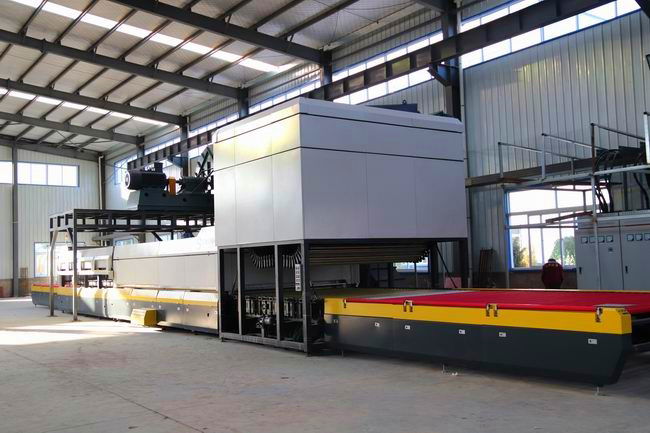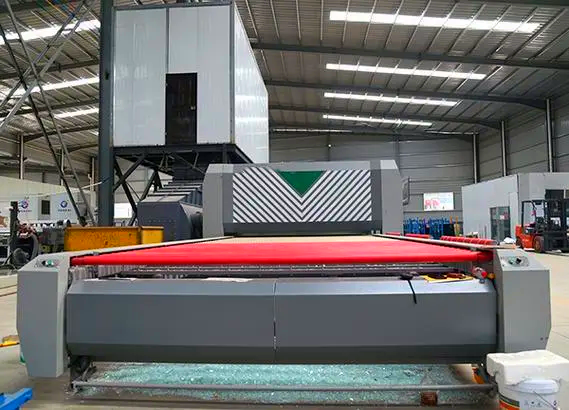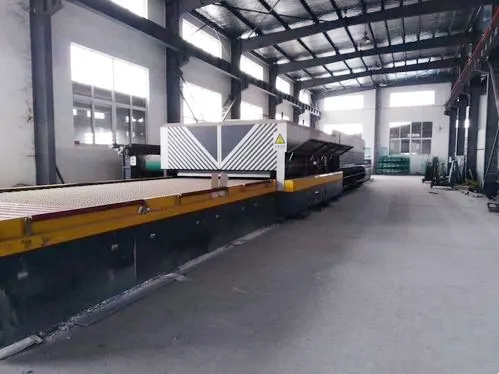Research on energy-saving technology of glass tempering equipment.

The rapid development of science and technology has brought a variety of technologies into the public eye, and glass tempering technology is one of the representative products.Glass tempering technology can be traced back to around 1930. After more than 80 years of development, related technologies have gradually matured. Glass tempering is a follow-up process. If any problems occur during the tempering stage, or defective products appear, it will inevitably affect the cost investment. Therefore, a high degree of attention must be paid to the glass tempering process. To better meet the current needs of tempered glass production, manufacturers have begun to actively explore energy-saving technologies, advocate the use of more ideal key measures, and formulate reliable measures to ensure more ideal production results.
1. The specific methods of glass tempering
The glass tempering method is a scientific choice based on actual needs and is judged based on the specific requirements of glass tempering to ensure that the chosen method conforms to the actual situation and can achieve ideal life, production, and multiple goals. The most critical aspect of glass tempering is to reasonably change the mechanical properties of the glass itself and broaden its scope of use. The basic principle of glass tempering is that after the glass is properly heated and then rapidly cooled, the tensile stress of the glass itself is reflected, thereby generating corresponding compressive stress on the surface, achieving ideal results. During the whole process of glass tempering, its safety performance is effectively improved, its strength is strengthened, its thermal stability is very ideal, and it can meet the actual needs of different aspects of life. Glass tempering methods cover two types: chemical and physical. The working principle of physical tempering is to use a heat transfer medium to complete the heating treatment of the glass material, and appropriately present the extremely rapid cooling state in the cooling medium, to obtain a more reliable tempering effect. Chemical tempering uses chemical means to rationally transform the composition of the glass surface, so that the compressive stress of the glass itself can be gradually increased, thereby promoting steady changes in its mechanical properties. Compared with physical tempering methods, chemical tempering can effectively consolidate the properties of the glass itself, avoid obvious deformation problems, and make the quality more ideal. However, chemical tempering is less efficient and involves higher costs.
2. The energy-saving ideas for glass tempering equipment
As people's awareness of energy conservation gradually increases, energy-saving ideas should be integrated into the production of tempered glass, and scientific and reasonable energy-saving ideas should be paid attention to ensure that glass tempering equipment reaches ideal energy-saving standards. The heating process is used to make the heat absorption of the glass relatively uniform. To achieve the goal of energy saving, the system can be used to complete basic operations. In work practice, it is also necessary to pay attention to scientific energy-saving ideas, steadily improve the production efficiency of glass tempering equipment, and ensure that the energy-saving effect is better.
2.1 Optimize the structure and process of the heating section
Uniform heating of tempered glass is an important issue, and heating parameters need to be scientifically controlled. The new generation of glass tempering equipment optimizes the machinery and insulation material laying structure and improves the production process, which significantly improves the heating efficiency and reduces the energy consumption of tempered glass production. It is also very helpful for the heating uniformity during the glass tempering process and can improve the tempered glass. The overall quality of the product.
2.2 Optimize the structural layout of the cooling section
Cooling of glass tempering is an important step, which can have a direct impact on the quality and strength of tempered glass. During the actual research on the new generation of equipment, the changes in the tempered cold air temperature field and blowing field have become the focus of attention. The use of scientific and reasonable tempering and cooling process separation schemes, and the optimization of the cooling zone structure, can promote the tempered glass production stage to reflect the ideal tempered quality.
2.3 Optimize heating and cooling control system
With the popularization of laser infrared temperature measurement technology for civilian use, advanced laser infrared temperature measurement technology is applied to the heating control system of glass tempering equipment, which can realize real-time monitoring of the surface temperature of tempered glass during the production process. On this basis, combined with in-depth research on the parameters of the PID control system, a corresponding and more advanced heating control system was developed, which not only greatly improved the heating efficiency, but also improved the uniformity of the tempered glass surface temperature during the production process, while effectively reducing production energy consumption, it also laid a solid foundation for further improving the quality of tempered glass.
3. The energy-saving technology of glass tempering equipment
Today, as the technical level has improved significantly, glass tempering technology has been rapidly promoted, and it has become the focus of much attention because of its advantages. In current practical applications, horizontal roller glass tempering equipment has become the mainstream of the market, which is of great help to the production of tempered glass and reflects extremely high utilization value. In addition to heating larger glass, it can also better adapt to the requirements of different products. Glass tempering equipment contains many important components. The basic heating method is all-electric radiation heating, and the basic source of heating is electric heating elements. Continuously improving the production process structure and control system level of glass tempering equipment can effectively improve production efficiency, reduce the heat loss of the glass tempering equipment itself, and reduce production energy consumption, thereby achieving the goal of energy saving and consumption reduction.
3.1 Optimize the combination of thermal insulation materials
Traditional glass tempering equipment uses at most 1 to 2 types of insulation materials. When choosing insulation materials, the main considerations are to keep the inside of the furnace clean and prevent slag from falling off. To improve the insulation effect, the thickness of the insulation materials is mostly adjusted. To achieve this, there is less research on thermal insulation efficiency. If the insulation material is thickened blindly, the equipment will have a large appearance and high cost. Therefore, the thickness of the insulation material should be controlled within an acceptable range, and the insulation effect will be average. To ensure the smooth realization of the energy-saving goal, different thermal insulation materials should be combined and applied reasonably. Using the characteristics of different thermal insulation materials with the lowest thermal conductivity in different temperature ranges, 3 to 5 types of thermal insulation materials should be selected and matched inside the glass tempering equipment. Within the temperature range of the layer during the production process, these insulation materials are arranged in an orderly manner from the inside to the outside of the tempering equipment, so that the performance of each insulation material can be maximized, which can not only save the amount of insulation materials, but also reduce the cost. Equipment costs are reduced, and the heat loss of the glass tempering equipment itself is effectively controlled, reducing production energy consumption.
3.2 Multi-station heating technology in the furnace
This technology has a very obvious utilization value, and when used in specific applications, the actual energy-saving effect is very significant. The heating furnace section of the glass tempering equipment contains multiple stations along the length of the furnace. Different areas are formed according to specific specifications. By swinging back and forth in the area, basic operations can be completed within a specific period. After reaching a specific temperature, it will be transferred to the subsequent workstation in time. The manufacturing process of tempering furnaces is significantly different, and the structural differences are very obvious, but the specific furnace temperatures are the same. Multi-station glass tempering equipment needs to reasonably control the temperature difference in the furnace within a specific range to avoid the problem of glass bursting in the tempering furnace. Appropriately reducing heat loss will be of great help in scientifically achieving the purpose of energy conservation and emission reduction, and can also make the basic results of tempered glass more ideal. The application of multi-station technology in some tempering furnaces with specific structures, such as equipment whose heating section length is much longer than the cooling section length, can significantly increase the speed of glass tempering production to about 1 to 2 times, compared with traditional The production process has reduced production energy consumption by more than 45%.
3.3 Thermal break bridge technology
The parts used for heating and convection in glass tempering equipment, such as furnace wires, heating fans, etc., are placed inside the heating furnace body and fixed to the outer frame of the furnace body through a mechanical connection structure. This connection is equivalent to establishing multiple heat transfer channels outside the furnace body, causing the heat in the heating furnace body to be continuously and rapidly transferred to the outside of the furnace body along the connecting parts, greatly increasing the heat loss of the glass tempering equipment. Therefore, in the structural design of glass tempering equipment, the priority is to minimize the connection channels between the parts in the heating furnace body and the external frame. Secondly, for the external connection structures necessary for high-temperature fans and furnace wires, it is necessary to reasonably add air partition structures and parts made of materials with low thermal conductivity such as non-metallic materials such as ceramics to block the transfer of heat from the inside to the outside. Compared with traditional tempering furnaces, the application of thermal bridge technology can significantly reduce the surface temperature of the heating furnace body, reduce heat loss, and reduce production energy consumption by 10%.
Figure 1 The special structural design of glass tempering equipment 1
3.4 Optimize the cooling section structure with the help of advanced professional fluid software analysis
As the hardware requirements for temperature and fluid software gradually decrease and the analysis capabilities become increasingly powerful, the temperature field and cooling airflow diagram of the entire cooling section can be simulated with the help of simulation analysis of professional temperature and fluid software. Multiple arc-shaped grid plates are installed at the junction of the heating section and the cooling section, and the arc-shaped plates of each layer are arranged at intervals and arranged into a structure with equal height difference to orderly guide the edge layers on the glass surface to move from empty to vertical. It effectively prevents cold air from disturbing the heating temperature in the tempering furnace and overcomes the defect of "backflow of air" from the cooling section to the heating section of traditional glass tempering equipment. Optimize the blowing angle and air hole arrangement, and design the wind box cross-section into a streamlined structure to ensure that the blowing air quickly tears the hot air boundary layer on the glass surface, improve the blowing efficiency, and speed up the discharge of heat from the glass surface. These improvement and optimization measures have significantly improved the glass cooling efficiency compared to traditional tempering furnaces, ensuring the production of high-quality glass tempering and energy saving and consumption reduction. The energy consumption in the cooling section has been reduced by 15%.
Figure 2 The special structural design of glass tempering equipment 2
3.5 Intelligent control technology
To better realize the purpose of energy saving and meet ideal energy-saving needs, we should pay attention to the application of advanced technology in our work. The application of laser infrared temperature measurement technology in glass tempering equipment provides technical support for accurate and real-time monitoring of glass surface temperature. Based on this technology, a more advanced temperature control module is adopted, combined with in-depth research on PID parameters in the actual production process, and through a reasonable and scientific intelligent control process, according to the glass variety, specifications, and equipment loading rate in the actual production process different from each other, the heating time can be controlled timely and accurately, the heating power of the upper and lower sides and different areas of the heating furnace can be adjusted, and the proportion of the fan's heat transfer to the glass heating process can be adjusted to ensure that the temperature of the glass coming out of the furnace is more accurate. The heat absorption of the commercial surface is more symmetrical and uniform, making the glass surface relatively flat and truly achieving the ideal purpose of uniform heating. The scientific application of this technology can promote heating efficiency to new heights and levels, and achieve more complete energy-saving benefits.
Figure 3 The special structural design of glass tempering equipment 3
4. The conclusion
To achieve the purpose of energy conservation and emission reduction, the manufacturing industry should use high-efficiency and energy-saving technologies in the glass tempering production stage, and appropriately use various solutions such as convection heating systems and self-heating convection circulation systems in the furnace to make glass tempering heating more uniform and achieve ideal results. Energy saving and consumption reduction goals ensure that the results of equipment use are more significant. This article explains in detail the specific methods of glass tempering and explains the energy-saving ideas of glass tempering equipment. It is further elaborated and analyzed based on specific energy-saving technologies, aiming to provide reliable reference opinions for the majority of industry peers and the long-term development of the glass tempering industry. Provide an effective reference for development.
For more information about LIJIANG Glass insulating glass processing equipment and insulating glass processing accessories, please click here to learn more





